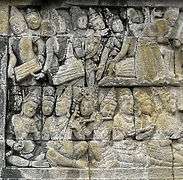Slenthem
The slenthem (also slentem or gender panembung) is a Javanese metallophone which makes up part of a gamelan orchestra.
The slenthem is part of the gendér family.[1] It consists of a set of bronze keys comprising a single octave: there are six keys when playing the slendro scale and seven when playing the pelog. These keys are suspended by leather cords over individual bamboo tube resonators in a wooden frame, which are cut so that the placement of the bamboo's node causes the functional length of the resonator to be shorter for higher notes. The instrument is played by striking the keys with a mallet, called a tabuh, which has a short handle and a thin wooden disk edged in cloth or rubber. One hand is left free to dampen notes.[2] It is a low-pitched instrument[3] with a softer sound than the saron demung.[4]
Like the saron barung and demung, it generally plays the most basic form of the melody (balungan) in a composition.[5] However it also sometimes uses techniques similar to the saron to elaborate. It is especially favored in quieter gamelan ensembles (such as Gamelan Gadhon); but it is a part of standard Gamelan Gedhé as the only soft-style instrument also played in loud-style pieces.
It is typically placed among the instruments at the front of the performing area.[6]
References
- ↑ Hood, Mantle; Maceda, José (1972), Music, Brill Archive, ISBN 978-90-04-03402-0
- ↑ Gaetano Jr., Mario A. (Spring–Summer 1978), "Definite pitched idiophones of the Javanese gamelan" (PDF), Percussionist, 15 (3): 121–143
- ↑ Benamou, Marc; Supanggah, Rahayu (2006), Indonesia, Central Java: Solonese Gamelan: A Garland of Moods (PDF), Maison des Cultures du Monde
- ↑ Dean, Deirdre (July 1996), "The classroom gamelan" (PDF), Counterpoint: 31–37 Archived June 15, 2005, at the Wayback Machine.
- ↑ Kartomi, Margaret J. (1990), On Concepts and Classifications of Musical Instruments, University of Chicago Press, pp. 101, 104, ISBN 978-0-226-42549-8
- ↑ Kartomi, Margaret J. (1990), On Concepts and Classifications of Musical Instruments, University of Chicago Press, p. 89, ISBN 978-0-226-42549-8


